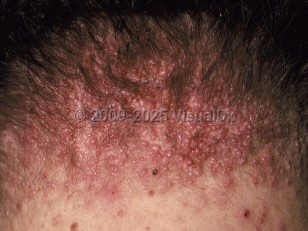Acne keloidalis nuchae - Hair and Scalp
Alerts and Notices
Important News & Links
Synopsis

Acne keloidalis nuchae (AKN), or folliculitis keloidalis, is a chronic inflammatory disease in which pustules and keloid-like papules and plaques occur at the nape of the neck, occipital scalp, and sometimes extend up to the vertex scalp. Despite its name, it is generally accepted that the lesion is not associated with acne, is not a true keloid, and can occur beyond the nuchal area.
The presence of keloids at other locations or having a family history of keloids are not features of the disease. The overwhelming majority of patients with AKN are young Black men. AKN has been reported in other racial and ethnic groups, including individuals of Hispanic and Korean descent and White people. Women are rarely affected unless they shave their hair at the nape of the neck. AKN is rare in patients before puberty or after age 50.
The condition is often painful and disfiguring. Inflammation of the hair follicle and fibrosis of the tissue typically result in scarring, including scarring alopecia. The etiology is unclear; many different hypotheses and factors have been proposed. Inflammation is key in the pathogenesis of AKN; however, whether inflammation is a primary or secondary phenomenon is unclear. Earlier literature suggests that AKN was a form of mechanically induced folliculitis, and it is known that AKN is associated with localized mechanical irritation from shirt collars, football or military helmets, or trauma from shaving or haircuts. Despite this association, AKN has been classified as a primary form of inflammatory scarring alopecia.
The strong male predilection suggests that androgens play a role in pathogenesis. It has been discussed in the literature that the kinky, curly nature of Black hair and the tendency of this curvature to lead to penetration of the skin and development of ingrown hairs (which is known to be pathogenic in pseudofolliculitis barbae) could play a role in the pathogenesis. However, histology and dermoscopy have not demonstrated ingrown hairs to be a feature of AKN. There is also no reported association between the occurrence of pseudofolliculitis barbae and AKN.
Another proposed mechanism is aberrant immune reaction to various antigens including cosmetic products, sebum, Demodex, bacterial skin flora, or dermatophytes. One study showed a higher incidence of seborrheic dermatitis in patients with AKN, raising the question of whether dermatophytes could play a role in pathogenesis.
Other factors that have been suggested are obesity and metabolic syndrome, and certain medications.
The presence of keloids at other locations or having a family history of keloids are not features of the disease. The overwhelming majority of patients with AKN are young Black men. AKN has been reported in other racial and ethnic groups, including individuals of Hispanic and Korean descent and White people. Women are rarely affected unless they shave their hair at the nape of the neck. AKN is rare in patients before puberty or after age 50.
The condition is often painful and disfiguring. Inflammation of the hair follicle and fibrosis of the tissue typically result in scarring, including scarring alopecia. The etiology is unclear; many different hypotheses and factors have been proposed. Inflammation is key in the pathogenesis of AKN; however, whether inflammation is a primary or secondary phenomenon is unclear. Earlier literature suggests that AKN was a form of mechanically induced folliculitis, and it is known that AKN is associated with localized mechanical irritation from shirt collars, football or military helmets, or trauma from shaving or haircuts. Despite this association, AKN has been classified as a primary form of inflammatory scarring alopecia.
The strong male predilection suggests that androgens play a role in pathogenesis. It has been discussed in the literature that the kinky, curly nature of Black hair and the tendency of this curvature to lead to penetration of the skin and development of ingrown hairs (which is known to be pathogenic in pseudofolliculitis barbae) could play a role in the pathogenesis. However, histology and dermoscopy have not demonstrated ingrown hairs to be a feature of AKN. There is also no reported association between the occurrence of pseudofolliculitis barbae and AKN.
Another proposed mechanism is aberrant immune reaction to various antigens including cosmetic products, sebum, Demodex, bacterial skin flora, or dermatophytes. One study showed a higher incidence of seborrheic dermatitis in patients with AKN, raising the question of whether dermatophytes could play a role in pathogenesis.
Other factors that have been suggested are obesity and metabolic syndrome, and certain medications.
Codes
ICD10CM:
L73.0 – Acne keloid
SNOMEDCT:
49265008 – Folliculitis keloidalis nuchae
L73.0 – Acne keloid
SNOMEDCT:
49265008 – Folliculitis keloidalis nuchae
Look For
Subscription Required
Diagnostic Pearls
Subscription Required
Differential Diagnosis & Pitfalls

To perform a comparison, select diagnoses from the classic differential
Subscription Required
Best Tests
Subscription Required
Management Pearls
Subscription Required
Therapy
Subscription Required
References
Subscription Required
Last Reviewed:02/02/2021
Last Updated:05/18/2023
Last Updated:05/18/2023
 Patient Information for Acne keloidalis nuchae - Hair and Scalp
Patient Information for Acne keloidalis nuchae - Hair and Scalp
Premium Feature
VisualDx Patient Handouts
Available in the Elite package
- Improve treatment compliance
- Reduce after-hours questions
- Increase patient engagement and satisfaction
- Written in clear, easy-to-understand language. No confusing jargon.
- Available in English and Spanish
- Print out or email directly to your patient
Upgrade Today

Acne keloidalis nuchae - Hair and Scalp

